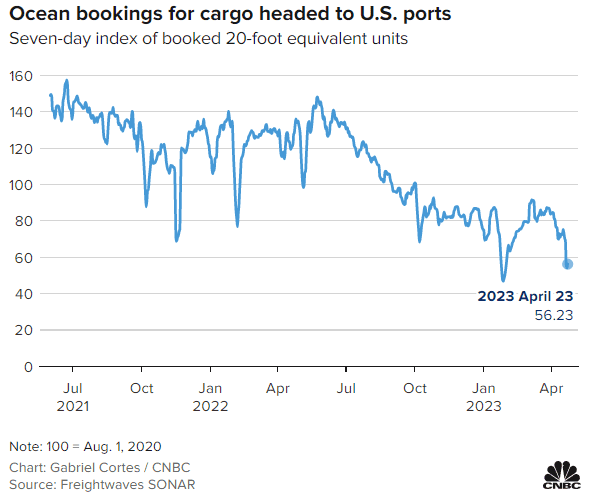After 24 month or so of clear sailing and record profits following the start of the COVID Pandemic in 2020, it is the opposite now, with many carriers fighting for their financial lives.
Supply Chain Digest Says... |
 |
|
| Berglund told theLoadstar that he believes carriers “are in a tight spot” as demand has been hit by economic and geopolitical factors, which have put shippers “in the driving seat” during negotiations. |
|
 |
|
What do you say? |
|
| Click here to send us your comments |
|
| |
|
| Click here to see reader feedback |
|
|
|
In the face of container volumes in steep decline since mid-2022 (see graphic below), all the power is the hands of shippers.
A report last week from consulting firm Maritime Strategies International (MSI), says spot rates are “at their lowest sustainable level”, but that at least they are stable there, while contract terms are still under negotiation for many and “there is further room for weakening in terms of contract freight rates.”
The maritime analysts at Drewry say there WCI (Asia to US West Coast) composite index showed a 2% week-on-week decline, to $1,740.26 per 40-foot container, 78% down huge on the same week last year.
According to Drewry, rates out of Shanghai to Rotterdam and Los Angeles fell 1% and 2%, respectively, and Rotterdam to New York also fell 2%.
According to web site theLoadstar, Xeneta’s view of contract settlements “was brutal, suggesting the shipping industry had “endured a torrid time in April”, with long-term contract rates falling 10.6%.
Xeneta says bottom basement spot rates and having a big impact on contract pricing.
"A raft of newly negotiated contracts, with prices reflecting the low market demand and high capacity, dragged rates down across the board – with all regional trade lanes registering month-on-month declines,” the Xeneta report added.

(See More Below)
|
CATEGORY SPONSOR: SOFTEON |
|
|
|
|
|
Its XSI index shows rates in all trades have slumped 13.6% this year, with CEO Patrik Berglund adding: “This is now the eighth consecutive month of falls and, at over 10%, certainly one of the most noteworthy.”
TheLoadStar quotes Berglund as saying he believes carriers “are in a tight spot” as demand has been hit by economic and geopolitical factors, which have put shippers “in the driving seat” during negotiations.
“To demonstrate the sea change in market sentiment here, they [contract rates] were up 118.5% between April 2021 and April 2022. So, given that fundamentals remain weak, it looks unlikely that year-on-year growth will be maintained much longer. We can very likely expect further falls.The decline in global trade is the root cause of the rate collapse, with supply and demand driving pricing power in the end as aways.
Berglund told theLoadstar that he believes carriers “are in a tight spot” as demand has been hit by economic and geopolitical factors, which have put shippers “in the driving seat” during negotiations.
“To demonstrate the sea change in market sentiment here, they [contract rates] were up 118.5% between April 2021 and April 2022. So, given that fundamentals remain weak, it looks unlikely that year-on-year growth will be maintained much longer. We can very likely expect further falls.”
What are your thoughts on container rates? Let us know your thoughts at the Feedback section below.
Your Comments/Feedback
|

